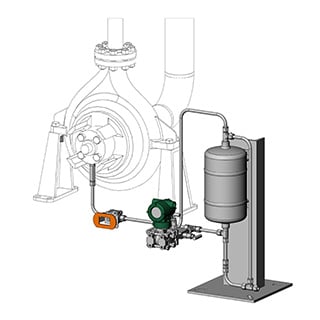Share this
Don’t Build a Mechanical Seal Support With Just an Assembly Drawing—There’s Help Available in Northern California
by Morgan Zealear on 9/28/21 9:00 AM
 As mechanical seals are mission-critical to operations, so too are the seal support systems. Assembling a mechanical support seal system requires components to be correctly aligned and outfitted for an operation’s conditions. Failure to do so may result in leaks, pressure malfunctions (build-up or drop off), and unwanted temperature shifts.
As mechanical seals are mission-critical to operations, so too are the seal support systems. Assembling a mechanical support seal system requires components to be correctly aligned and outfitted for an operation’s conditions. Failure to do so may result in leaks, pressure malfunctions (build-up or drop off), and unwanted temperature shifts.
Choosing the best seal support design and features requires understanding the different types of seal support plans. These plans include flush plans, buffer/barrier plans, and leakage collection plans. Further, these different plans have several options to customize the seal support plan based on operation specifications. With many options to consider, it is best to work with an expert in assembly services to design a mechanical seal support system, customized to your unique needs instead of relying on a general mechanical seal support assembly drawing.
Types of Configurations of Seal Support Systems
If assembled correctly and with the optimal operation design, seal support systems produce peak seal performance through proper lubrication and cooling. They may prevent wear and ultimately leakage of the seal. There are numerous designs and guidelines for seal support systems. The most common used by refineries is the standards of the American Petroleum Institute (API). There are several different design options to fit operations to meet API standards, including the type of seal piping and flush plans.
Types of Seal Piping and Flush Plans
Several different flush plans are available depending on operations. Flush plans flush fluid into the pump seal chamber. One option is for a flush plan that uses internal porting. Internal porting plans direct flow from the process to the seal chamber (Plans 01, 02, 03). Another option is an external porting plan that can utilize either the process fluid or an external source as the flush fluid. API Plan 32 is a typical example of this plan and often uses water as its external source.
There are also buffer/barrier plans. Buffer plans collect while barrier plans introduce inert media that bleeds across the seal into the process fluid.
The seal piping plan also depends on the intended service conditions. Though the mechanical seal arrangement contributes significantly to which seal piping plan is used, many other conditions influence the seal piping plan. This selection can become quite complex based on the refineries’ various processes.
Though any of these options could be ideal depending on the design, layout, and processes of refinery operations, there are ways to customize further and optimize seal support systems.
Mechanical Seal Support Customization for Operation Optimization
Mechanical seal support systems can be customized to best fit refinery processes. These additional customizations build upon plans to add additional filtration methods, allow for modified routing, and deliver fluid from external sources.
Building Upon a Common Flush Plan
A common flush plan—Plan 11, for example—takes fluid from the high‐pressure section of the pump and recirculates it through flow control openings to the seal. Many plans build upon design Plan 11 through additions. These additions can include a strainer or cyclone separator for filtration (Plan 12, 31), modified routing (Plan 13, 14), a cooler (Plan 21), or a combination of these options (Plan 22, 41). Further modifications include separating the flush flow from the impeller area of the pump (Plan 23). In this plan, flush fluid is circulated from the seal chamber, through a cooler, and back into the seal chamber.
External porting plans also have many components which can be built upon. For example, these plans can have additional valves for shutoff and flow control as well as strainers for filtration. Additionally, instruments can be added to measure pressure, temperature, and flow.
With all these options available, it is vital to have an expert to help with choosing the right plan and correctly integrating that plan into operations via a customized mechanical seal support assembly drawing.
Rely on a Customized Mechanical Support Seal Assembly Drawing for Efficient Refinery Operations
Assembling and integrating a mechanical support seal into refinery operations can be difficult. There are numerous design decisions and customization options for a mechanical support seal. These include the flushing plan and the seal piping plan used.
Customizations may be necessary if additional flow control measures and instrumentation are preferred. To optimize your processes, it is ideal to work with an expert when selecting a mechanical support seal plan and when assembling a mechanical support seal plan.
Swagelok can help select, design, and assemble a seal support system that goes for any Northern California refinery’s specific application. Nearby in the Bay Area, we have a top-tier team of certified Field Engineers ready to help you with all of your seal system selection, design, and assembly needs.
We can fabricate your seal support system to the highest ISO 900 quality standards. When you are ready to install it, Swagelok Northern California will be standing behind our work with a Lifetime Warranty—the best in the industry. When it comes to seal support system selection don’t build a mechanical seal support system with just an assembly drawing, let us be your customized solution.
To learn more about how Swagelok Northern California can help you with your specific mechanical support seal system needs, contact our team today by calling 510-933-6200.
 Morgan Zealear | Product Engineer – Assembly Services
Morgan Zealear | Product Engineer – Assembly Services
Morgan holds a B.S. in Mechanical Engineering from the University of California at Santa Barbara. He is certified in Section IX, Grab Sample Panel Configuration, and Mechanical Efficiency Program Specification (API 682). He is also well-versed in B31.3 Process Piping Code. Before joining Swagelok Northern California, he was a Manufacturing Engineer at Sierra Instruments, primarily focused on capillary thermal meters for the semiconductor industry (ASML).
Share this
- Archive (465)
- Assembly Services (207)
- About (100)
- Seal Support Systems (96)
- Best Practices (88)
- Training Services (74)
- Fittings (51)
- Semiconductor Applications (49)
- Hoses and Flexible Tubing (47)
- Regulators (44)
- Tubing (42)
- Grab Sampling Systems (32)
- Sampling Systems (32)
- Gas Systems (30)
- Services (30)
- Downloads (29)
- Valves (24)
- Application Support (18)
- Orbital Welding (17)
- Case Studies (13)
- Steam Systems (13)
- Frequently Asked Questions (12)
- Tools (12)
- Measurement Devices (7)
- Subsystems (6)
- Thermal Management (6)
- September 2023 (1)
- August 2023 (2)
- June 2023 (1)
- March 2023 (3)
- February 2023 (3)
- January 2023 (4)
- December 2022 (4)
- November 2022 (4)
- October 2022 (4)
- September 2022 (1)
- August 2022 (3)
- July 2022 (2)
- June 2022 (4)
- May 2022 (1)
- April 2022 (2)
- March 2022 (1)
- February 2022 (2)
- January 2022 (3)
- December 2021 (1)
- November 2021 (6)
- October 2021 (6)
- September 2021 (8)
- August 2021 (4)
- July 2021 (3)
- June 2021 (6)
- May 2021 (6)
- April 2021 (7)
- March 2021 (5)
- February 2021 (4)
- January 2021 (6)
- December 2020 (5)
- November 2020 (6)
- October 2020 (6)
- September 2020 (8)
- August 2020 (7)
- July 2020 (8)
- June 2020 (8)
- May 2020 (6)
- April 2020 (9)
- March 2020 (7)
- February 2020 (10)
- January 2020 (21)
- December 2019 (23)
- November 2019 (21)
- October 2019 (22)
- September 2019 (21)
- August 2019 (22)
- July 2019 (23)
- June 2019 (20)
- May 2019 (23)
- April 2019 (22)
- March 2019 (21)
- February 2019 (20)
- January 2019 (21)
- December 2018 (14)
- November 2018 (19)
- October 2018 (23)
- September 2018 (17)
- August 2018 (29)
- July 2018 (11)
- June 2018 (6)
- May 2018 (5)
- April 2018 (4)
- March 2018 (5)
- February 2018 (3)
- January 2018 (3)
- December 2017 (2)
- November 2017 (4)
- October 2017 (3)
- September 2017 (2)
- August 2017 (6)
- July 2017 (4)
- June 2017 (4)
- May 2017 (4)
- April 2017 (3)
- March 2017 (4)
- February 2017 (3)
- January 2017 (3)
- December 2016 (3)
- November 2016 (3)
- October 2016 (3)
- September 2016 (5)
- August 2016 (5)
- July 2016 (4)
- June 2016 (5)
- May 2016 (3)
- April 2016 (4)
- March 2016 (5)
- February 2016 (11)
- January 2016 (1)
- December 2015 (3)
- November 2015 (4)
- October 2015 (3)
- September 2015 (4)
- August 2015 (4)
- July 2015 (8)
- June 2015 (5)
- May 2015 (3)
- April 2015 (4)
- March 2015 (4)
- February 2015 (3)
- January 2015 (4)
- December 2014 (2)
- November 2014 (3)
- October 2014 (4)
- September 2014 (4)
- August 2014 (4)
- July 2014 (5)
- June 2014 (4)
- May 2014 (4)
- April 2014 (5)
- March 2014 (4)
- February 2014 (3)
- January 2014 (4)
- December 2013 (5)
- November 2013 (3)
- October 2013 (4)
- September 2013 (3)
- August 2013 (5)
- July 2013 (5)
- June 2013 (5)
- May 2013 (3)
- April 2013 (6)
- March 2013 (4)
- February 2013 (4)
- January 2013 (8)
- December 2012 (4)
- November 2012 (6)
- October 2012 (6)
- September 2012 (4)
- August 2012 (4)
- July 2012 (4)
- June 2012 (4)

.webp?width=210&height=70&name=StickyLogo%20(5).webp)